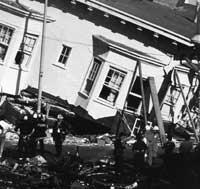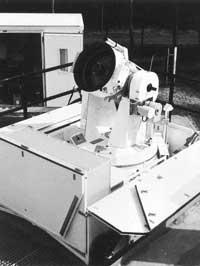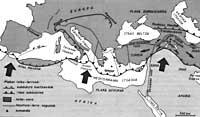Fighting against earthquakes
1994/07/01 Aizpurua Sarasola, Joxerra Iturria: Elhuyar aldizkaria
Along with the chilling figures of the dead, we must not forget that every year the average economic damage exceeds one billion dollars.
At present, the high existing buildings in our society, the high speed transports, the gas pipes, the water tanks and the thermal and nuclear power stations can increase the massacres generated by the earthquake. At the moment there are many states that are investigating to prevent earthquakes. The idea that the impact of earthquakes not only on buildings, but also on general development plans is increasingly accepted.

Although in the European sphere they can occur in almost any place, the Mediterranean area is the one that has had the most dead. See attached table.
Africa and Arabia are exerting increasing pressure in Eurasia, which is reflected in the Mediterranean area. Greece is the land with more earthquakes; almost every day one can say that there is an earthquake. At the beginning of the century, that is, between 1903 and 1932, the greatest earthquakes, that is, 7 or more intense on the Richter scale, occurred in the north. The south was the area most affected by earthquakes in the following four decades and in the last two decades the north has once again become the most punished zone.
Faced with this situation, the Greek government created in 1983 the Organization for the Protection and Prevention of Earthquake (EPPO), which was subsequently supported and disseminated by the European Council. So far, the work of the PGPUE has been formative, both at the level of citizenship and of government or administration. As a result of this work, the Greek government has drawn up a plan that takes into account all strata of society and, therefore, from ministers to students, everyone knows what to do in case of an earthquake. At the same time, technical research is being carried out, both in the updating of construction standards and in water, energy or communications supplies.
In the past, the construction bases imposed by the engineers were the result of a recent earthquake. But since not all earthquakes have the same characteristics, it is necessary to modify the construction standards. For this purpose, the Technical University of Athens has the most advanced seismic panel in Europe, allowing to study structures with a movement of up to six degrees of freedom.
The prediction of earthquakes would be a spectacular breakthrough, but so far it has been achieved in very few cases. In 1975, in the Chinese city of Hai Txeng, local authorities succeeded in advancing the earthquake because people were expelled from the city. So it was very few dead. But this is the only case in which success has been achieved in this matter. Sometimes there has been no forecast and, therefore, there have been great killings. On other occasions, in California, for example, there were false predictions; after putting the media there was nothing.
Once aware of the importance of prediction, the main problem is not only to detect signals that predict an earthquake, but to know when it can occur, since the cities of the always empty earthquake zones cannot be maintained.
As a warning signal, change of frequency of the microlurrica, change of velocity of the seismic waves, movements of the pavement, changes in the water level, etc. They are taken. The Japanese, for example, analyze 24 different phenomena in the real-time warning system. For Greek scientists, the changes in electro-telluric currents are, above all, of special importance.

However, all seismologists affirm that it is at the beginning of seismic prediction. Therefore, it is still necessary to analyze the different events and establish their relationship with the earthquake.
The most basic prediction that can be made is that if a city has suffered an earthquake, something before or after will suffer another. Therefore, although it is understandable that people want to rebuild the destroyed village in the same place, it is not appropriate.
But, can great earthquakes be predicted?
Movements between plaques causing most earthquakes cannot be paralyzed, but there are those who think that the tension generated in these movements can be released in small and numerous earthquakes. To do this, it has been proposed to inject water into the crevices of the soil or to blow nuclear bombs at great depths, but for the moment the above proposals are fictional.
In view of the proposals and massacres caused by earthquakes, more and more institutions are emerging to be able to carry out studies on the earthquake. However, in most institutions, the objective is to train, that is, to socialize the immediate measures to be taken in case of an earthquake. Along with this, it should be noted that the parameters taken into account in the design of buildings by earthquakes are increasingly reliable, but ensuring that tomorrow a terrible earthquake will occur is for now equivalent to the dream.

Gai honi buruzko eduki gehiago
Elhuyarrek garatutako teknologia




